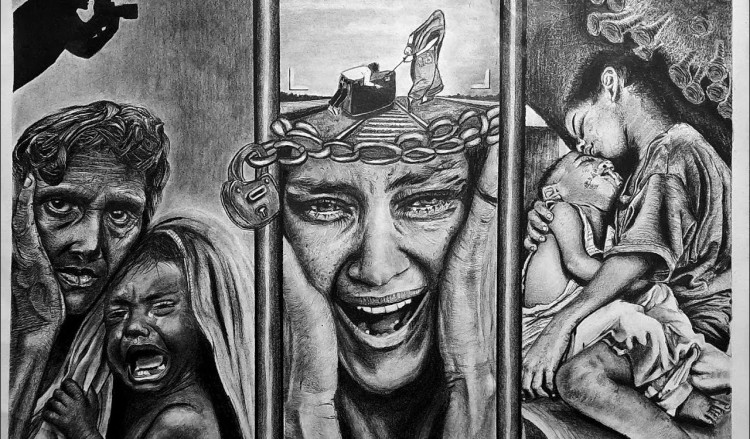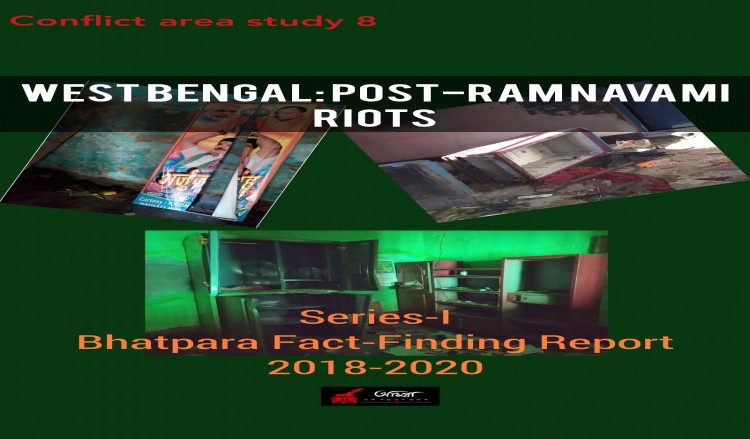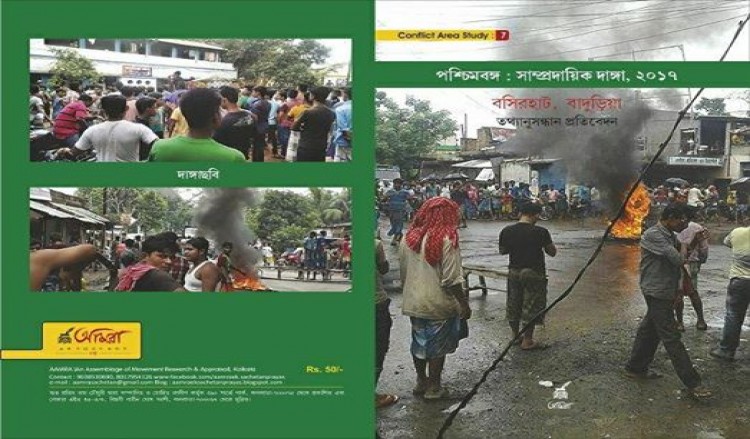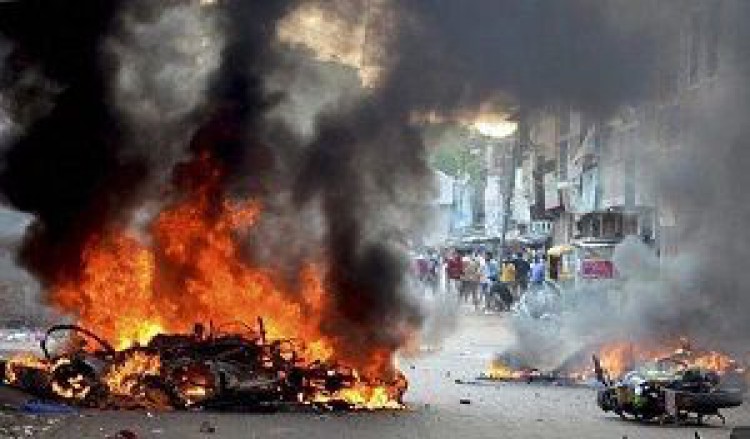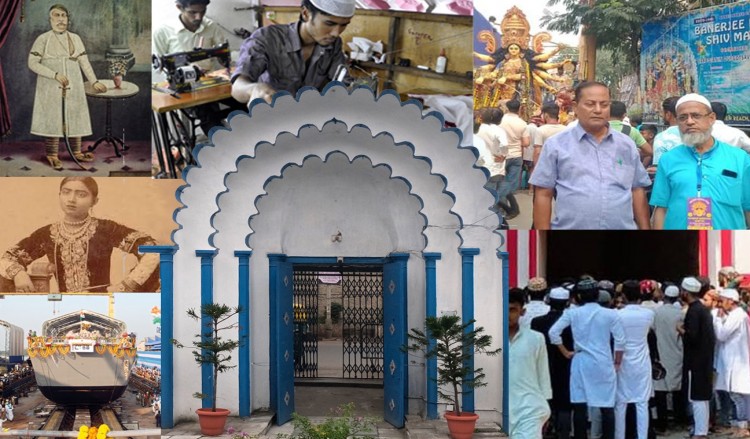
Festival, 2024: Garden Reach Fact-Finding Report: Series-I
This report will focus on the communal conflict that took place in the Garden Reach area of Kolkata in the year of 2024 during Durga Puja. As part of a series of fact-finding reports by An Assemblage of Movement Research and Appraisals (AAMRA), the study delves into the social and historical contexts that shaped the incident, using ethnographic research and interviews with key stakeholders to amplify marginalized voices often overlooked by mainstream media. The report highlights the escalation of tensions following a viral video allegedly showing Muslim youths disrupting a Durga Puja celebration, the subsequent dissemination of inflammatory content on social media, and the role of political rhetoric in exacerbating communal divisions.
Garden Reach Fact-Finding Report, 2024
This report will focus on the communal conflict that took place in the Garden Reach area of Kolkata in the year of 2024 during Durga Puja. As part of a series of fact-finding reports by An Assemblage of Movement Research and Appraisals (AAMRA), the study delves into the social and historical contexts that shaped the incident, using ethnographic research and interviews with key stakeholders to amplify marginalized voices often overlooked by mainstream media. The report highlights the escalation of tensions following a viral video allegedly showing Muslim youths disrupting a Durga Puja celebration, the subsequent dissemination of inflammatory content on social media, and the role of political rhetoric in exacerbating communal divisions.
The analysis situates the Garden Reach conflict within the broader historical narrative of the area, tracing its transformation from a rural village to an industrial hub under colonial rule, its association with figures and events. This includes figures like Nawab Wajid Ali Shah, and events like the gruesome Great Calcutta Riots, rise of nationalist-religious politics in colonial India. It also revisits critical events, including the labor agitations of 1939, the great Calcutta riots in 1945-47 and the riots in 1992 following the demolition of Babri Masjid, to contextualize the enduring socio-political complexities of the region. This report aims to provide a nuanced understanding of the intersection between historical grievances, contemporary communal tensions, and their implications for collective identity and harmony in West Bengal.
Introduction
This is one of the many reports An Assemblage of Movement Research and Appraisals (AAMRA) is about to publish on Durga Puja Conflict in West Bengal, this year. Through extensive research on ethnography of a region, we conduct interviews with stakeholders in a conflict and attempt to represent the lesser heard voices, the ones who would otherwise be suppressed by mainstream media. This year West Bengal has witnessed several conflicts around the Durga Puja ceremony. Implications of such conflicts on the mass psyche could be havoc if not studied critically. This is because Durga Puja is considered more than just a festival, it is a part of the Bengali identity. The epicenters of these recent conflicts are Garden Reach, Shyampur, Rajabazar and Dakshindari. Our first report in this series is intended to shed some light on the conflict that took place in the Garden Reach Area.
The Garden Reach Conflict
A thirty second video went viral on social media platform X (formerly Twitter) of a group of young Muslim men allegedly attacking a Durga Puja Mandap in ward 133. This incident occurred on Friday, October 11th, at the New Bengal Sporting Club premises. It was the time of Jummah, post noon. The devotees were praying at the local mosque. Allegedly some Muslim youths came to the pandal and made offensive remarks as the music being played during the Durga Puja, was disrupting the Jummah prayers. The Muslim youths had an argument with the people of the puja committee. Soon after, the elders of the Muslim community intervened and tried to calm the youths. The situation came under some control. The puja committee filed a complaint with the police.
Photos and videos of the incident started being disseminated like wildfire, without much heed to the context. This disrupted peace not only in the area of conflict but in the whole of West Bengal where twitter users took to peddling both grievance towards the alleged vandalism and hatred towards the Muslim community. BJP leader Suvendu Adhikari visited Garden Reach. His subsequent speech on the Durga Puja conflicts were highly inflammatory, inciting divisive sentiments among communities. On October 15, representatives from 'AAMRA, Ek Shachetan Prayas' visited the area to engage with various community members. Interviews were held with the local puja committee, the mosque committee, and several local shopkeepers.
Historical Background
Metiabruz is known well in history because of its connection to the exiled Nawab Wajid Ali Shah, the eleventh and last king of Oudh.The Nawab arrived in May of 1856 with his relatives, attendants, musicians and cooks who is believed to have come from both Shiya and Sunni sects.The Nawab had transformed his exile by building Imambaras, palaces, mosques and even a zoo, essentially attempting to build a mini-Lucknow within the British capital. The Nawab was renowned for patronage towards arts and music; he had written and staged a play: ‘Radha kanhaiya ka Kissa’ on the eternal love of Radha and Krishna, symbols of Hindu religion and literary traditions. He had brought with him almost thirty thousand Urdu speaking Muslims. Before 1856 Metiabruz was vastly inhabited by Sunni Muslims. The demography of this area can be categorized into Urdu/Hindi speaking Muslims and Bengali speaking Muslims. Mid-nineteenth century saw the development of Metiabruz from a village to an industrial area, under British rule.The Keshoram Jute mill was once called Ghyanshyamdas Birla Jute mill, established in 1939, was the oldest mill in the area. The Urdu/Hindi speaking Muslims arrived as migrant laborers for the textile industries in the area from different villages of Uttar Pradesh, Madhya Pradesh, Chattishgarh and Bihar. Laborers even came from Odisha, Punjab and Telangana. From interviews recorded in the AAMRA archive, we have observed that these people came from the villages and settled for generations to work at the Keshoram Jute mill, Indian South Jute mill, Lawrence Jute Mill, Clive Jute Mill, and Victoria Jute mill, subsequently settling in quarters and colonies. After the extension of Kolkata Port into Garden Reach, Metiaburz became a den of criminal activities. This saw the rise of several anti-social figures including Ayub Ansari who once infamous as the ‘Don’ of Metiabruz also came from Dariabad, a village in Uttar Pradesh. He was believed to have played a seminal role in both criminal and communal conflicts in the area. Local sources have also revealed the crucial role that individuals like B A Roshan and Hrishikesh Pal played to de-escalate the 1946 riots in this area. Three major incidents that are believed to have shaped the political landscape as well as public perception of the Metiabruz-Garden Reach area are: the Labour agitations of 1939, the 1946 riot and the 1992 riot. We will briefly discuss these incidents in the light of today’s public sentiments.
The labor agitations of 1939
The labor agitations in the jute mills of Metiabruz-Garden Reach during the early 20th century played a significant role in shaping the political and social landscape of the area. These mills, including the Keshoram, Indian South, and Victoria Jute Mills, were established under British colonial rule and employed large numbers of migrant laborers from Uttar Pradesh, Madhya Pradesh, Chhattisgarh, and Bihar. These workers, living in overcrowded quarters, faced exploitative working conditions. The labor movements of 1939 were particularly significant as they coincided with anti-colonial uprisings across Bengal. These agitations were not merely economic; they also carried the seeds of political consciousness among the working class, uniting them against oppressive systems. Oral histories from the AAMRA archive shows how these protests were instrumental in fostering solidarity among the Hindus and Muslims residing in the area.The legacy of these labor agitations remains an integral part of Metiabruz-Garden Reach’s historical memory, influencing subsequent movements and shaping the socio-political dynamics of the region. (AAMRA Archive Interviews).
The 1946 riot
The 1946 riots left a profound stain in the historical record of Kolkata and India. The book Back to History: The 1946 Kolkata Riots offers insight into the nature of these riots, particularly in the Metiabruz-Garden Reach area. Contrary to some accounts, the working-class people of this district were not spared from the violence. Metiabruz-Garden Reach, a key working-class neighborhood in Kolkata, experienced severe riots; armed gangs destroyed the Lichubagan workers' slum and attacked a Radhakrishna temple. Many impoverished laborers from Bihar and Uttar Pradesh were killed in the violence. The riots reportedly began in response to rumors that Muslims had been killed in Bhawanipur, with escalations following as bodies arrived in the area, triggering widespread violence and looting against Hindus. Amid the turmoil, acts of bravery emerged: a worker named Ali Hasan, along with several others, sheltered approximately 50 Hindus, safeguarding them from the surrounding violence. As an aftermath of the violence, it spurred several conflicts in Noakhali, Bihar and Punjab that year.
The 1992 Riot
The 1992 riots in the Metiabruz-Garden Reach area were a pivotal moment in the region's communal history, deeply intertwined with the nationwide fallout from the demolition of the Babri Masjid in Ayodhya. The riots underscored the fragile communal fabric of the locality, which had long been home to a diverse population of Bengali-speaking Hindus and Muslims alongside migrant workers from northern India. Tensions flared as communal propaganda spread rapidly, exacerbated by rumors and local provocations. Clashes erupted between communities in Metiabruz, known for its dense Muslim population, leading to widespread violence, arson, and loss of life. Eyewitness accounts recorded in the AAMRA archive highlight the role of external actors, including political groups and local strongmen, in escalating the violence. The events of 1992 marked a shift in the area's socio-political dynamics and increased polarization.
The 1992 riots in Metiabruz-Garden Reach, as reported in by the Association for Protection of Democratic Rights (APDR), reveal the mortifying scale of violence in the region. These riots shattered the complacency and pride of Kolkata's citizens by exposing the fragility of communal harmony in areas like Metiabruz-Garden Reach in the west and Tangra-Tiljala-Entally in the east.
The report highlights how a nexus of local goons, political patrons, and complicit law enforcement took control of affected neighborhoods for days. Efforts by political parties to promote communal harmony were absent, and the general public was unable to organize any meaningful resistance against the violence.
In Lichubagan, a neighborhood within Metiabruz, Hindu residents were targeted on December 7, resulting in the deaths of three laborers and one shopkeeper. Several slums were burned, over 120 homes were destroyed, and many families sought refuge in the Kesoram Cotton Mill. The violence was allegedly orchestrated by Jhunnu Ansari, a notorious local criminal and brother of an independent councilor supported by the CPM. Thousands of people participated in these attacks, and despite the presence of senior police officers, no efforts were made to save the slum.
The destruction was indiscriminate: Muslim-owned shops, such as Bahar Ali's tailoring shop, were also vandalized. Six sewing machines in one shop were completely destroyed by fire. Areas like Mithaitala, home to jute mill workers, saw 20–25 houses burned and a Shiv temple desecrated. While local leaders like Abdul Ali, Abdul Khaleq, Nizamuddin, and CPI's Mannan attempted to mediate and stop the violence, they were largely unsuccessful.
Jhunnu Ansari, the alleged provoker, allegedly remained visible near the Metiabruz police station even days after the riots. His family, according to locals, maintained opportunistic ties with various political parties, including BJP, switching allies as it suited their interests.
Crime, Communal Conflict and Coexistence
Crime and communal conflict is believed to have become predominantly intrinsic in this area. So much so that in the pretext of a conflict, the idea of coexistence is vastly a myth, memories of coexistence have been washed away from public memory by repetitive hammering of the mainstream media. Media portrayal of Metiabruz is especially tainted with communal colours. It is believed by the public that the area has seen the rise of notorious crime bosses who played a seminal role in communal conflict. Public perception of these anti-socials is such that it is believed that they have flourished under the shelter of political parties so they could easily get away with killing people either for occupying territory, or communalism. There have also been instances where these notorious anti-socials have escalated disputes to communal conflict while the vast majority of common people remained oblivious. Notably, some port Mafias like Mainuddin Shahzada and Jahangir also known as Mughal, played the role of Robin Hood in the area.
The Metiabruz-Garden Reach area has a long standing history of communal conflict in the pre and post-independence era; continued to today’s present. The Garden Reach area falls under the jurisdiction of five police stations: Garden Reach, Metiabruz, Nadial, Rajabagan, and Rabindranagar. This region has witnessed multiple instances of communal incitement, and (un)successful attempts at de-escalation, as documented in various sources, including newspapers, books, and fact-finding reports maintained in the AAMRA Archive.
When Harmony is Intrinsic to Human Nature
Before reaching our destination, we met a puja committee member, busy preparing for the Puja Carnival organized by the state government on Red Road in Kolkata. We spoke to two officials of the Banerjee Bagan Shiv Mandir Public Durga Puja Committee. Sushil Kumar Dubey and Abdul Wajid. As per the dress code of the carnival, many of the organizers were wearing blue Punjabi and white pajamas. Wajid Sahib was also in the dress code of the committee.
Interviews with Locals and Stakeholders of the Area
Interview with Subir Das Modak, owner of an age-old Mishti shop
We spoke to the owner, Subir Das Modak who runs a 55 year-old food shop in the area. The shop belonged to his father which he later inherited. In this area of mixed population, people of all classes come to his shop. In the morning, he makes and sells Ghugni parathas. Here is the summary of the conversation with him-
Shopkeeper: We didn't know much about this incident but this has happened before.
AAMRA : Can you share more on that?
Shopkeeper: Trouble related to playing loud music or chanting mantras during Azaan time… is not new to us. There is an old puja in this neighborhood, Muslims objected to playing loud music, the police didn't give permission to the Puja committee. But the Bengali Muslims of the locality told Hindus, “Just keep it low during the Azan, else it's alright”. We didn’t get to know about this incident until much later.
AAMRA: This is quite an old puja, why is it that the Police would not permit it?
Shopkeeper: No, this is something that happened 17-18 years back. When they first started the pujas.
AAMRA: So nothing happened this time to that puja pandal?
Shopkeeper: No, there was no dispute at that puja pandal.
AAMRA: Is the puja where the dispute happened this time new?
Shopkeeper: No, it’s older than that.
AAMRA: Then what’s the reason for the dispute here?
Shopkeeper: The loud speakers were blaring, it wasn’t a Hindi song or a catchy song, it was a Bengali song.
AAMRA: Did they go and request them to stop playing the song, or what…?
Shopkeeper: So the thing is, if they would have asked them not to play songs before the Azan then it would have been alright. Instead what they did was, they started to gather here after the Namaz.
AAMRA: Was it that some people from the same gathering were seen stopping the rest?
Shopkeeper: Yes, we saw them too. Some were trying to de-escalate the situation. See, I don't know much, I am a busy person. If something happens, I will lower down the shutters of my shop. When I heard about the dispute, I was very prompt at closing down my shop.
AAMRA: What happened inside the Pandal then?
Shopkeeper: I don't know much. But you know how it works right? People make mountains out of molehills. Some say that the Durga murtis were vandalized, some say the children were attacked, some say that the mob had threatened them. But as far as I know, they did not do anything to the durga murti. If anything would have happened, it would have been a big deal. In protest of this incident, our Hindus stopped buses and blocked the roads. The roads were jammed.
AAMRA: What was the demand for this blockade?
Shopkeeper: Incarceration of the miscreants.
AAMRA: So didn't anyone get arrested?
Shopkeeper: I don't know much, I only keep to myself. Everyone is equal to me.
AAMRA: Have there ever been any trouble in your neighborhood before?
Shopkeeper: There have been many troubles before. We saw it in our childhood. The hand of a Kali deity was broken. The mosque was set on fire. That was a big deal, there was a curfew. I was 5-6 years old then. Again, there was unrest in 1992 when the Babri Masjid was demolished.
AAMRA: Is this the mosque from which there was an objection towards pandals after the Friday Namaz, is this mosque for both Bengali and Bihari Muslims?
Shopkeeper: No, it is for Bengali Muslims. Bihari Muslims caused the unrest that day.
Interview with Gautam Manna, (New Chittaranjan Athletic Club)
We spoke to him in the club room. He was accompanied by another member of the club. Gautam Manna is the cashier of the club. The conversation recorded is as follows:
Gautam Manna: Look, some people caused trouble and ran away. The rest said that it was wrong, they made a mistake.
AAMRA: Muslims admitted that it was wrong?
Gautam: Yes. But not those who did it, they ran away. Not everyone is like that, there are some good people too. They behaved badly, but what can the rest do? And someone made a video of the entire incident and posted it on social media. As a result, everyone here knows about it.
AAMRA: Has there ever been such a dispute before?
Gautam: As in, here (pointing towards an unused pond in front of the clubhouse,across it is an abandoned place in the middle of buildings) someone might have consumed marijuana and created a disturbance. Then a dispute broke out. The police came. But long ago, there was a Hindu-Muslim dispute, we were young then, we don't know exactly.
AAMRA: You also have a puja,right, did you turn off the mic during the Namaz?
Gautam: (hesitatingly) We act wisely. We don't want to create any unrest. We turned it off ourselves.
AAMRA: That means you act wisely during the call to Namazr, why?
Gautam: We turn it off even when someone dies.
AAMRA: That's normal.
Gautam: They have a majority here, the majority will always make the rules of a place.
AAMRA: Yes, the majority does define a lot.
Gautam: Yes, that is true, here they (Muslims) are more, so they have a good hold of the area. But see, ruckus is everywhere - between brothers, between localities, between religions, it is everywhere.
AAMRA: This time there was unrest at the puja next to you. Tell me more about that.
Gautam: I was sleeping at that time. I later found out there was a blockade so the cars were stopped. Later the Chairman came, and this other person called Moktar, he came. Later Shuvendu Adhikari came.
AAMRA: What did Shuvendu Adhikari say?
Gautam: Those who did it did the wrong thing. They can't stop Durga Puja. The BJP is with you. He said.
Interaction with the Imam of Mudiali Jama Masjid and some local Muslim people present with him
Viral posts on social media suggested that worshipers from the Mudiali Jame Masjid had partaken in the alleged attack on the durga puja committee. Some other worshippers tried to stop them. The video that went viral on various social media is giving such 'information'. Initially, our conversation started at the door of the mosque. Fatehpur Village Road is nearby. We requested that there was no sound of vehicles outside, can we go inside and talk? Imam Mohammad Sadiq Ali agreed, but the female member among us was not allowed. She had to stay outside. Women are not allowed to enter the mosque.
Imam: The matter is being kept alive even after it has been resolved.
AAMRA: Would you say there is politics involved in that?
Imam: On Jumma day we were praying, Namaz was just almost over, no? (Pointing to another worshiper present there during the interview). Yes, it was just over, the mosque was very crowded that day, the upper and lower floors of the mosque were almost full. Some worshippers offered Namaz outside, as in on the road. Among them, most are youngsters. We were all inside, I stood at the forefront, I knew nothing. I heard about the incident just as you did. The music was either loud or was intentionally turned up, so boys from the mosque asked them to stop the music. The opponents were also all present at that time. A chaos was created. Some of our seniors went and chased them and brought them back.
Local People 1: He (Imam) prohibited the boys on mic.
Imam: Yes I announced it on the mic.
Local People 1: The ruckus was created by outsiders, they are not from our locality. Both Hindus and Muslims of our area are religious and peaceful, they mind their own business.
Local People 2: People present in the dispute were non-bengalis. Bengali boys won't do such a thing.
Imam: Then the Puja committee lodged a complaint with the police. The police called for all the Imams in the area. We all went to the local police station on Friday evening. We had a discussion there, it was agreed upon that the kids have been at fault and forgiveness would be granted to them. The puja committee members agreed to discuss the proposition. The councilor of our ward that is 134 no. ward paid a visit to the police station. The police had captured four of the miscreants and released them by the next morning.
AAMRA: Where were they from?
Imam: Three were from the neighboring para, and one was from our para. Many people were involved in the ruckus, many people were also trying to stop the dispute.
AAMRA: We see a gradual rise of polarization through both electronic media and social media, what are your views on this?
Imam: Yes I am aware. Zee TV came to me once but they cherry picked parts of my speech and circulated them. After that the meaning of my speech changed, I have always encouraged peace in the area, I have admitted that it was a fault.
AAMRA: We saw this video on a viral post on social media (showing the video from phone to the Imam), is this your masjid?
Imam: No this is neither our Masjid, nor is it a Masjid of our area.
AAMRA: Then where is this Masjid?
Local People 2: We don't know.
AAMRA: We have come from an organization working on peace and harmony, 'Amra, Ek Shachetan Prayas'. We appeal to the puja committee and the mosque authorities for peace and coexistence. When we came here, we met the puja committee of Banerjee Bagan, people from both communities are involved in this puja. They were getting ready to go to the carnival. This message of harmony should be propagated, but it is not being propagated.
Local People 2: This is the picture here, there has been no trouble here till date. You can also ask Hindus. This is the work of a few bad boys. Should they have informed the mosque committee, or told the Imam Sahib. There was a police posting there, they could have gone and told them, we were offering prayers and music was being played loudly.
AAMRA: Was there a police posting there at that time? I heard there were civic police presence.
Local People 1: Anyway, they could have gone and said, turn down the sound, let our prayers be over. The prayers were almost over, there was only a little left.Then Shuvendu Adhikari came, and then he started making everything viral.
AAMRA: Did Shuvendu Adhikari talk to you?
Imam: No, he didn't talk to us.
AAMRA: We spoke to a nearby puja committee, they said that BJP people came and incited the fight again. They are saying this even though they are Hindus. It is appropriate for us to inform them, not everyone is one-sided. Some Hindus are communal, while some Muslims are communal.
Imam: Yes, of course. As I said.
Local Peiple 2: BJP is trying to create a big deal out of this.
AAMRA: Look, as there is BJP, there is also Jamaat. What is the intention behind this conflict over the call to prayer during puja? Puja is held four days a year. Call to prayer is heard every day of the year.
Imam: Of course.
AAMRA : If any Puja committee says this is the time for Azan, we keep the music low, make less noise, or if the Mosque says that Puja comes for only four days a year, so we lower the sound of Azan for a few days, it can done but it requires mutual respect and love for each other’s religion. All incitements only work in the dearth of harmony. In absence of harmony anyone can do politics with religious sentiments, be it BJP or the Jamaat.
Imam: You are right.
AAMRA: It is our request to all, we are telling everyone, try to know each other's culture, understand each other's sentiments. If we are of any use, let us know.
Imam: Of-course we will let you know. One thing I wanted to mention, they generally turn off the mic during Azan, there never was any unrest related to this.
AAMRA: Was the music played loudly on the microphone that time?
Imam and others: That sound did not reach inside the mosque. We were inside, we did not hear any sound. Those who went to the pandal were on the street, they must have heard the sound.
Local People 2: No, it was turned off, someone must have turned it on.
Imam: Maybe they thought the prayers were over, so they must have turned it on.
AAMRA: It means there was a communication gap.
Local People 3: The boys who went should not have gone. Didn’t I say, they were non-Bengalis? They only come once in a while in Jumma, and leave as early as they can. They offer namaz in 10 minutes and leave.
Imam: And the Namazis who come here for five “waqts” a day, will never do such a thing. Regular Namazis will never mess around in such a thing.
Interview with Tabrez Ansari
(40 years old; grandson of Ayub Ansari, nephew of Jhunnu Ansari and son of Samsudjamman Ansari (ex-MIC, now councillor of ward 134), an accomplished businessman of the locality)
AAMRA: What exactly happened that day?
Ansari: The incident is trivial and is nothing like it seems in the viral video. Subhendu Adhikari is instilling Hindu sentiments by creating a big deal out of a small dispute. The local people of Mudiali do not know what happened here. A few young boys may have made a mistake by objecting to the songs. Going and saying does not mean it is communal. It happens like this. People from the Muslim community chased those boys away. The video does not show the whole thing. But the videos are being spread in a different way. This kind of propaganda is being done on social media to exploit the sympathy of Hindus.
AAMRA: Has such an incident happened in Metiabruz before?
Ansari: Matiaburuj has a history. Once there were many gangsters. There were many poor slums. There was scarcity. There were problems. There were business disputes here. There were problems between brothers and brothers. There were political disputes. But there were no disputes over caste. You look into history. Look into police records. You won't find caste-based quarrels. Bengali Hindus and Muslims have always lived together here.
Mehta was murdered here. But it's not communal. Hindus and Muslims have died there. Muslims have killed Muslims. The Bengali Muslims have been here since eternity. None of the permanent residents here would want them to go to jail for these troubles. Those murders took place in the slum area of Ramnagar Batikal area. They are not local. Back in those days, crime was prevalent in these places. There were many thieves and criminals, now they have mostly aged. But Matiaburj is infamous for them. But now there are no thefts or pickpockets or criminal activity like before. Women are very secure in this area. Show me any case of touching girls here, you won't find it. Or show up being harassed, don't get it. People will kill if any miscreant commits such crime . Those murders took place in the slum area of Ramnagar Batikal area. They are not local. Crime is prevalent in these places. There are many thieves and criminals. Matiaburj is infamous for them. There is no extortion here. Businessmen from Burrabazar are shifting their shops here because Mangala Hat is not safe anymore. Money is being stolen there. But here there is no extortion or theft.
AAMRA: So you are saying that the situation has changed?
Ansari: This area used to be a melting pot of antisocial activities. But now they have aged. Many have died. Now people have jobs. The education rate has increased. There has been a lot of development. The slums have been developed. Here, Hindus and Muslims have all developed. It is not like the work situation has changed much, but there is a demand for work.
Debunking claims made during the conflict
Claim: BJP MP Suvendhu Adhikary tweeted on X that goons had attempted to storm into a Durga Puja Pandal at Garden Reach and threatened to vandalize the idol of Maa Durga if the rituals aren’t stopped.
Fact: A group of young Muslim men/boys objected to loud music during Jummah Namaz and was later stopped by elders of the community. The video shared by BJP leader Suvendu Adhikary as evidence of the incident is inconclusive since it shows a snippet of the incident, and not the incident in its entirety. The video shared along with a complaint to the Garden Reach police station claims that a Muslim mob had stormed into the Durga pandal is made to look like a threat against “Hindus” at large. Ironically, this is a common schema of disinformation dissemination by the far-right groups in India. Narratives built to set one community against another are heavily reliant on instilling fear and a notion of threat in a target community.
Analytical Observations from the Incident
The Role of Media and Politics
Right-wing leaning media outlets have played an instrumental role in sensitizing the incidents, exaggerating minor details, reducing the narrative to its favor that led to escalation of tension between the communities. Both communities expressed grievances about selective reporting, implying that the media might cherry-pick parts of the narrative and tweak it to their convenience, rather than lay out the whole story, therefore causing mistrust between the communities.
Platforms dominating Hindutva voices have repeatedly circulated biased news and videos which were amply shared that instilled communal sentiments.
The Hindutva forces of Bengal have carried out campaigns, attempting to capitalize on the incident and disrupt harmony in the area. BJP leader Suvendu Adhikari’s controversial comment on X: “This is Kolkata, not Dhaka” has instilled communal sentiments across Bengal. The narratives put forward by the Hindutva groups were heavily biased since it was based on an inconclusive video and selective cherry-picking of narrative elements to amplify disharmony.
The ruling party Trinamool Congress’s (TMC) was vastly passive in this incident. The TMC has refrained from any open statements in the media, attempting to suppress the incident. Their stance reflects an intent to downplay the growing intolerance among the communities, essentially ignoring the issue altogether.
Religious practices in West Bengal are becoming increasingly unregulated, with violations of noise restrictions during festivals and proliferation of new mosques and temples. The growing number of Durga Puja celebrations, enabled by government funding, reflects political motives. Such artificial displays of harmony aim to consolidate political power rather than foster genuine social cohesion.
The Role of Historical continuity and change
The Metiabruz-Garden Reach area has a history of both coexistence and conflict. Incidents such as the 1946 and 1992 riots left scars, but they also highlighted acts of humanity. Individuals like Ali Hasan in 1946 and Abdul Bari and Abdul Khaleque in 1992 attempted to mitigate violence and save lives. However, history often remembers conflicts while forgetting these reconciliatory efforts. Mainstream media has portrayed any and every news out of Metiabruz in a communal light and has put in much heed in ingraining communal sentiments among the public.
The difference in behavior between Urdu-speaking and Bengali-Speaking Muslims towards the neighbors of the area was reported. Mainly Bengali-speaking Muslims told us that their relation with Hindus is cordial, but they (Urdu-speaking Muslims) are hostile in nature, particularly their youths. This distinction, while noted, could not be deeply analyzed in this short-term investigation.
There is an increasing tendency to stop playing music and to stop preaching something on the microphone during the call to prayer (Azaan), although numerically it is not the overall picture. This tendency is manifested in Garden Reach.
Local traditions around shared cultural practices remain strained. For instance, some Durga Puja committees in the area voluntarily comply with noise restrictions during Azaan, reflecting either mutual respect or coercion, depending on the interpersonal dynamics of the communities.
The Role of Implications in Identity and Society
The incident at the New Bengal Sporting Club Durga Puja pandal, where Muslim youths allegedly caused disturbances, received widespread attention. However, the efforts of elderly and middle-aged Muslim residents to de-escalate the situation were largely ignored in media narratives.
Notion of coexistence in the region requires acknowledging both the reality of conflict and the potential for harmony.
The area remains sensitive, with locals reluctant to speak to outsiders due to fears of misrepresentation or involvement in political and administrative controversies.
No significant political or social initiatives were observed to build trust between the two communities. While measures like police deployment and CCTV installation were introduced, they focused on surveillance rather than fostering peace.
The controversy centering on a Hindu festival, a central part of the Bengali identity shows clear intent at disrupting peace among the communities.
Limitations of the Report
It is important to note that during our fact-finding investigation, we could not speak to all stakeholders. While we attempted to reach out to local political and administrative figures, only a few responded and set specific times for discussions. Despite our team’s efforts to meet them, our attempts were unsuccessful as they refused to engage. Thus, it cannot be said that this investigation is fully comprehensive. The insights shared here are based on the area's historical context and conversations with local residents.
Recommendations for Future
Identify and bring individuals responsible for disruption at the Puja Pandal under judicial process and ensure they face appropriate legal consequences.
Implement measures under relevant cyber laws to control and prevent the spread of communal incitement on social media platforms.
Facilitate meetings between local elected representatives, Puja committee members, and mosque management committee members to ensure such incidents do not recur in the future.
Initiate programs aimed at fostering mutual understanding of each other's cultural practices. Local governments and social organizations should take proactive steps to organize and support such initiatives.
References:
https://bangla.aajtak.in/kolkata/story/police-case-was-registered-for-creation-of-ruckus-inside-a-durga-puja-pandal-in-ward-no-133-of-kolkata-by-the-committee-rjk-1105171-2024-10-11?utm_source=atweb_story_share
https://www.youtube.com/watch?v=qlzLSYzewlw (Shuvendu Adhikari Premiered Oct 21, 2024)
[রাজ্যের বিভিন্ন স্থানে দুর্গা প্রতিমা ভাঙচুর ও সনাতনীদের উপর অত্যাচারের প্রতিবাদে সভা করেন শুভেন্দু অধিকারী। সেই সভা থেকে গর্জে উঠলেন তিনি। পাশাপাশি রাজ্য পুলিশের উপর ক্ষোভ উগরে দেন তিনি।]
https://x.com/SuvenduWB/status/1844700070618218525?ref_src=twsrc%5Etfw%7Ctwcamp%5Etweetembed%7Ctwterm%5E1844700070618218525%7Ctwgr%5E2ef64f5546ad1b170f53a86801e913b3b4ec522f%7Ctwcon%5Es1_&ref_url=https%3A%2F%2Fbangla.aajtak.in%2Fkolkata%2Fstory%2Fpolice-case-was-registered-for-creation-of-ruckus-inside-a-durga-puja-pandal-in-ward-no-133-of-kolkata-by-the-committee-rjk-1105171-2024-10-11 (Suvendu Adhikari on Oct 11)“How did the goons garner the ability to storm into a Durga Puja Pandal under the Jurisdiction of the @KolkataPolice and threaten to vandalise the idol of Maa Durga if the rituals aren't stopped?”
https://www.aninews.in/news/national/general-news/suvendu-adhikari-calls-for-police-action-after-threats-to-durga-idol-at-kolkata-pandal20241011215831/ ANI report on Garden Reach
Samaddar, R. (2016). Policing a riot-torn city: Kolkata, 16–18 August 1946. Journal of Genocide Research, 19(1), 39–60. https://doi.org/10.1080/14623528.2016.1224526
Pramanik, S. (2023). Mapping the pathways to anti-British demonstrations: Contextualizing the labour agitations of Bengal, 1939-43. Journal of People's History and Culture, 9(1).
‘ইতিহাসের দিকে ফিরে: ছেচল্লিশের কলকাতা দাঙ্গা’
Forgotten history: How the last Nawab of Oudh built a mini Lucknow in Calcutta, Deepanjan Ghosh, Scroll.in, 2018
Edited by Faruque Ul Islam, Bhumika Bhattacharyya
Fact-finding Team - Faruque Ul Islam, Bhumika Bhattacharyya and Subha Protim Roy Chowdhury
Cover- Suvankar Sen Gupta and Faruque Ul Islam
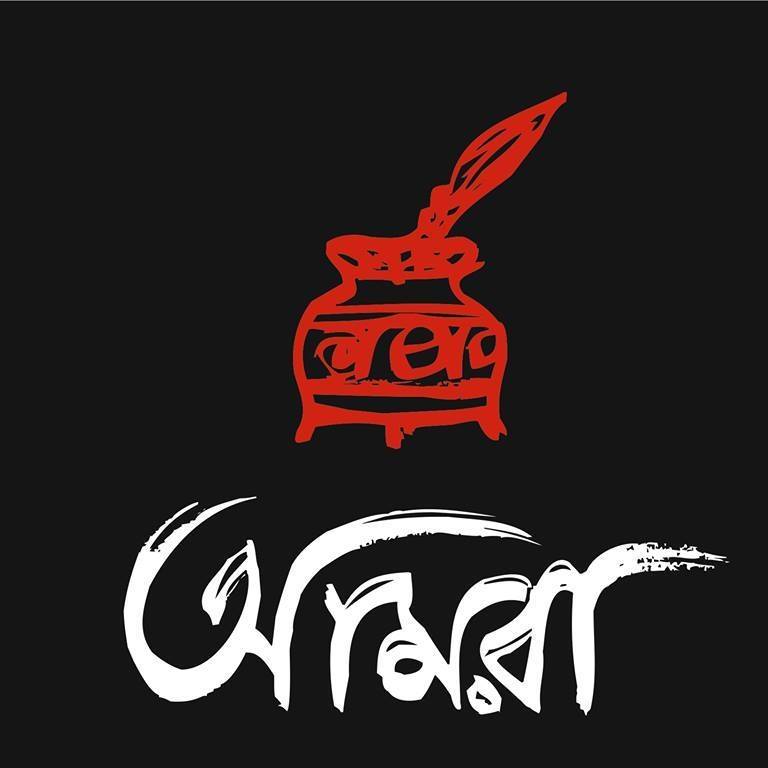
আমরা: এক সচেতন প্রয়াস
AAMRA is an amalgamation of multidisciplinary team of researchers and activists erstwhile worked as an assemblage of movement, research and activism. Popular abbreviation of AAMRA is, An Assemblage of Movement Research and Appraisal.-
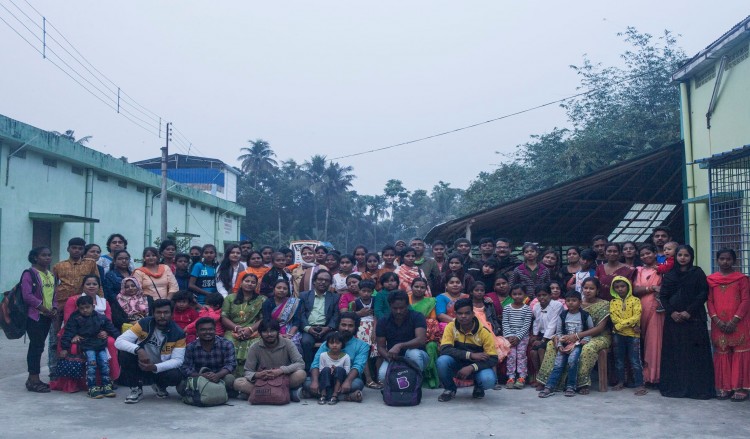
‘We are same boat-brother’, Picnic of Bengal Peace Centre, Bhatpara, 26 December, 2021
Our aim is not to only talk about peace but to involve... -
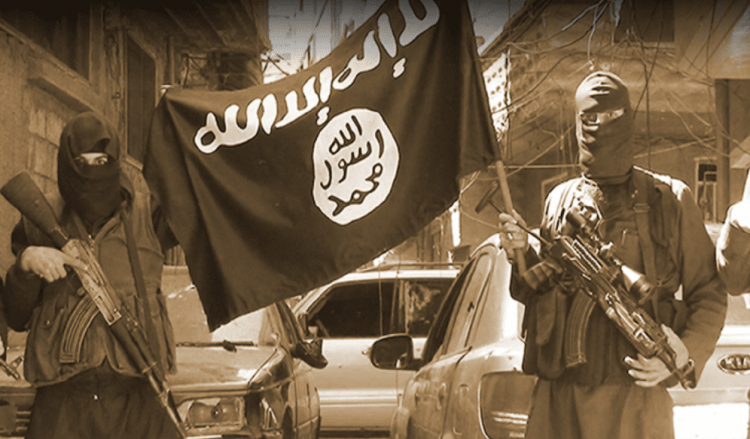
ভারতে করোনা ভাইরাসকে জিহাদের অস্ত্র করো - অনুগামীদের নির্দেশ পাঠিয়েছে আইএস
করোনা ভাইরাসকে অস্ত্র... -
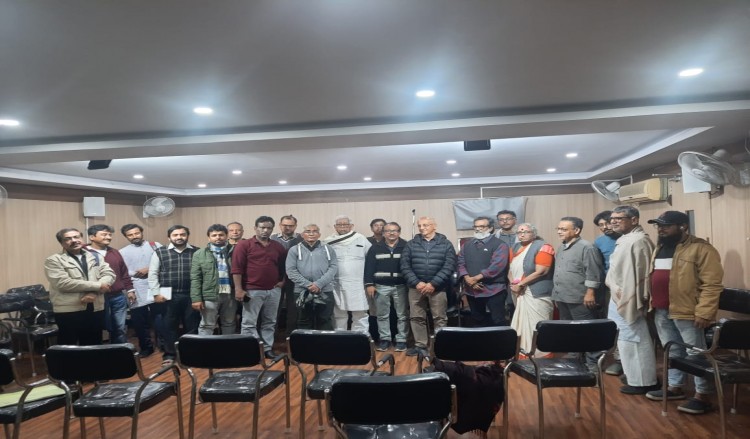
Discussion on plausible Agendas for the Lok Sabha Elections (2024) With Dr. Harsh Mandar, 23 January, 2024
Repealing all the Citizenship Amendment Acts and resuming... -
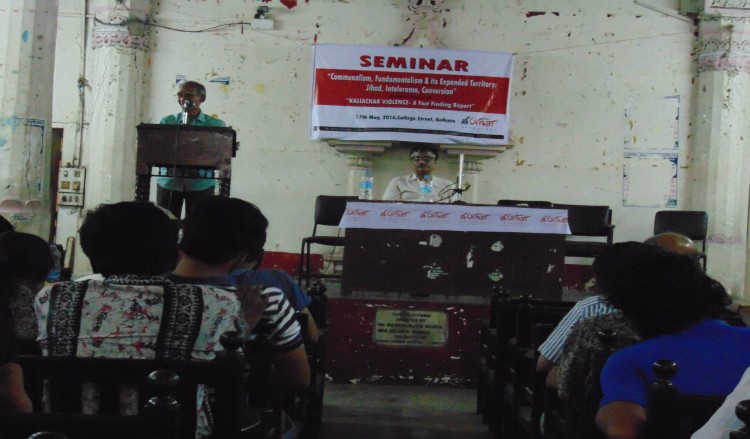
Seminar on Communalism, Fundamentalism and its expanded territory-Jihad, Conversion and Intolerance, Kolkata,16 May, 2016
On 16 May, 2016 we had organised a seminar on ‘Communalism,...
